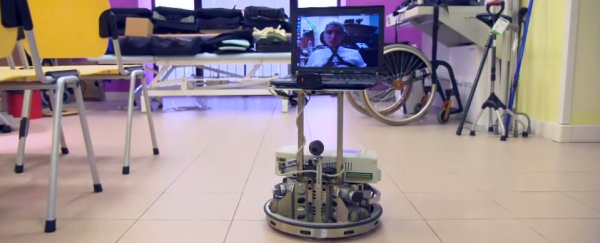Scientists have developed technology that's given paralysed people the ability control a robot remotely using just their thoughts, letting them visit new locations and interact with people in another country, all through a simple machine body.
If that all sounds very James Cameron's Avatar to you, you're not wrong - the premise here isn't actually that dissimilar. While people have already learnt to control machines, live animals, and even other people's arms, with their brain waves, the new research takes this a step further and combines Skype and basic robotics to create a remote body that allows a patient to feel as if they're exploring the world from their own bed.
To achieve this, 19 people - including nine quadriplegics and 10 participants who weren't disabled - across Germany, Italy and Switzerland were hooked up to an electrode-covered cap, which analyses their brain signals and converts them into electronic instructions for a robot.
These instructions were sent via the Internet to a remote computer hooked up to a simple, wheeled robot. Using just their thoughts, the patient's were able to easily move this robot around, seeing everything their robot does through Skype. The patient's face also appears on the computer screen.
"Each of the nine subjects with disabilities managed to remotely control the robot with ease after less than 10 days of training," lead researcher José del R. Millán, from the Ecole polytechnique fédérale de Lausanne (EPFL) in Switzerland, explained in a press release. You can see the robots in action below:
To make the robot easy to control without too much strain, its AI is capable of avoiding obstacles, even without instructions from the human operator. The robot can also continue on an indicated path on 'auto pilot' if the patient gets tired of giving it mental direction, which means that control is essentially shared between the robot and controller and allows the 'pilot' to take a rest while inhabiting this external body.
The team has been working on the system with the help of paralysed volunteers since 2008 as part of a European Commission-funded project, and the results have been published in Proceedings of the IEEE.
What's really cool is the fact that the trials showed no difference in piloting ability between disabled and non-disabled subjects, which means the technology puts us all on a level playing field.
The team also showed that disabled people who still had some mobility were able to control the robot by using their head to push nearby buttons, rather than their thoughts, if they wanted to.
But while Millán would like to see robots become a daily part of disabled people's lives, helping to supplement mobility and giving them new abilities, he's not sure how close we are to achieving this goal, due to the expense of such systems. "For this to happen, insurance companies will have to help finance these technologies," said Millán.
Let's hope this happens soon, because it would be really horrible to know that we now have the technology to restore some kind of mobility to disabled patients, and then not be able to deliver it to those who need it most. Maybe someone needs to get James Cameron in on this?
